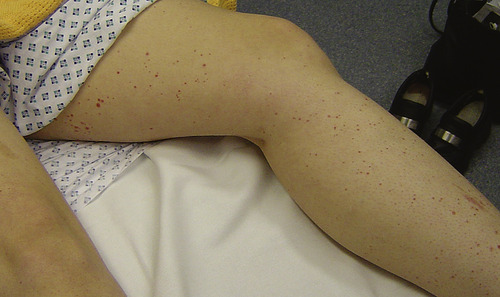CASE 26
 |
Incident
A 34-year-old female has presented to a rural community clinic with headache, back pain and a rash.
Clinical information at time of tasking:
• P 130.
• BP 70/40 mmHg.
• RR 28.
• GCS 15.
• Body temperature 35.9°C (96.6°F).
Relevant information
▪ Aircraft: Fixed wing
▪ Local resources: Nurse only clinic. land ambulance
▪ Retrieval options: General hospital
▪ Other: Estimated flight time 2.5 hours
Upon arrival of the PHR team, the nurse in charge hands over the following clinical information:
• Patient has received 2.5 L of crystalloid and a broad-spectrum antibiotic (cephalosporin) intravenously.
• P 130.
• BP 85/45 mmHg.
• RR 26.
• GCS 13 (E3, V4, M6).
Question
26.1 How will you further manage this patient with a view to retrieval?
Discussion
26.1 The patient has three criteria of the systemic inflammatory response syndrome (SIRS) plus evidence of infection, organ hypoperfusion and hypotension despite fluid resuscitation. The diagnosis is septic shock and it is recognised that prompt treatment will improve outcome. The destination is over 3 hours away when packaging, transfers and other factors are taken into account. The appropriate course of action is to begin treatment and attempt to stabilise the patient before transfer. A suggested path using an ‘ABC’ approach is described but simultaneous management is expected and the order of treatment may vary.
Airway
• The patient would be a reasonable candidate for prompt intubation regardless of the need for transfer but with a 3-hour trip pending, intubation is essential. Anaesthesia will also make the patient (who is currently confused) more manageable for other planned interventions. The risks of anaesthesia in an unfamiliar resource-poor environment are similar to the risks of anaesthesia by the roadside and the patient should undergo RSI, following a similar approach to that described in the pre-hospital section (see Case 6). In particular, careful attention should be paid to fluid loading the patient before induction, judicious use of induction agent and rapid access to a short-acting vasoconstrictor, if required. A careful check of the tracheal tube position must be carried out and documented and the tracheal tube firmly secured ready for patient transfer.
< div class='tao-gold-member'>
Only gold members can continue reading. Log In or Register to continue
Stay updated, free articles. Join our Telegram channel

Full access? Get Clinical Tree








